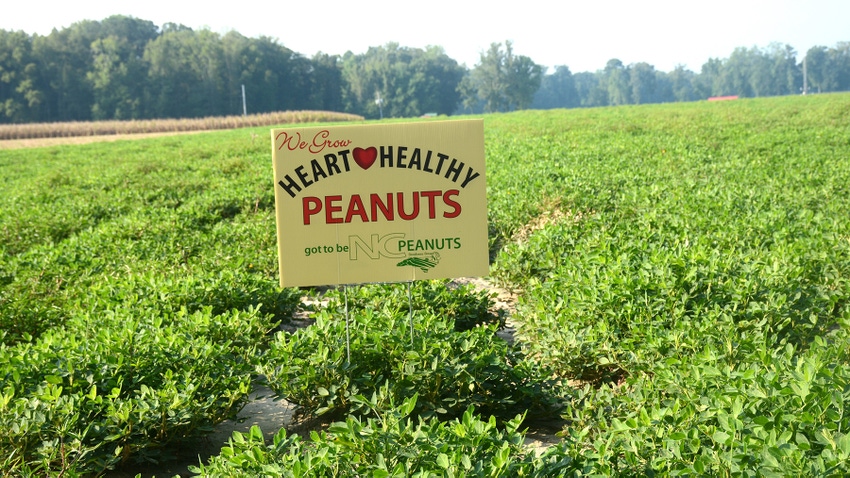
At a Glance
- Richard Owen, president and CEO of the American Peanut Council, emphasized export market where one-third of U.S. peanuts go.
- Argentina’s harvest was disastrous which is unusual, and this strengthened the export market for U.S. peanuts.
From aflatoxin and the impact of weather, to the biggest importers of U.S. peanuts and handling industry crises, a lot of ground was covered at the annual membership meeting of the North Carolina Peanut Growers Association Sept. 7.
Speakers touched on exports, reputation management, yields and crop conditions following the 71st annual peanut field day at the Peanut Belt Research Station in Lewiston-Woodville.
Among guests to take the stage was Richard Owen, president and CEO of the American Peanut Council whose discussion emphasized the importance of the export market where one-third of U.S. peanuts go. He said top export markets include Mexico, Canada, the United Kingdom, the European Union, Japan, and China.
Owen said the European Union has tight restrictions on aflatoxin, which presents hurdles to exporting U.S. peanuts to that market. He said the American Peanut Council is working with the EU, making the case that U.S. peanuts are grown safely and that the EU standards are stricter than they need to be to protect the EU consumer.
Sustainable U.S. Peanuts Initiative
Owen also urged peanut growers to participate in the Sustainable U.S. Peanuts Initiative where peanut farmers can document then communicate how they are sustainably producing peanuts. He said five growers enrolled for the 2022 crop year, and the Council hopes to double that number for this year. Enrollment for the 2023 program is now underway. Owen said it takes about one hour to enroll in the program.
“The benefit of enrolling in this program is to not only put in your information that’s been used in aggregate on the sustainability of peanuts, but it also compares your farm operation to the sustainability of your neighbors and then a national benchmark,” Owen said.
“It’s a way to document and show to manufacturers and ultimately consumers how responsible and how sustainable peanut farmers really are. Because you’ve got a great story. You know what the story is. We have to provide the documentation to do that,” he said.
Reputation management
Owen also emphasized the importance of reputation management in light of the 2008-2009 salmonella outbreak in peanut butter that killed nine people and sickened at least 714 others nationwide and resulted in a huge recall that severely damaged the reputation of peanut growers nationwide. The incident involved Peanut Corporation of America that sold tainted peanut butter.
Stewart Parnell, the former owner and president of the now defunct PCA, was sentenced to 336 months in prison by Senior U.S. District Court Judge W. Louis Sands of the Middle District of Georgia on Sept. 21, 2015 for conspiracy to defraud customers by shipping salmonella-positive peanut products.
Owen noted that the American Peanut Council was the organization that stepped up to defend the entire peanut supply chain during the 2009 salmonella crisis. He said the Council continues to devote resources to reputation management.
“I personally was involved in working with J.M. Smucker last year when they had their recall which took almost half of the peanut butter off of the shelf last year for a short period of time. They recovered their market share to 100% of what they were last year at the time. But it takes a team with experience to be able to offer support to be able to defend those issues when they come up,” Owen said.
Crop conditions
In the meantime, Dell Cotton, manager of the Peanut Growers Cooperative Marketing Association, gave an update on 2023 peanut crop conditions. He said U.S. peanut acreage totals 1,641,275 acres nationwide this year, up 18.5 % from last year. He noted that competing crops were much stronger for the past two years than they were this year.
He said Georgia increased peanut acreage to 760,000 acres. Missouri, which has been growing peanuts for just about five years now, increased to 20,368 acres, up from 18,000 acres last year.
“We in Virginia are only at 28,000 acres ourselves, so Missouri is becoming fairly prominent,” Cotton said.
North Carolina peanut acreage climbed up 6,000 acres from last year to 122,000 acres. “That’s the most in recent history,” Cotton said. Texas acreage jumped to 220,000 acres from 120,000 acres last year, an 83% increase.
“Texas is struggling with the same thing they did last year: that’s hot and dry weather. Cotton acres were abandoned just like last year. Last year, peanut yields averaged about 2,800 pounds to the acre. Whether they will do better or worse this year I don’t’ know, but they are struggling with some of the same issues,” Cotton said.
Yield update
As for the export market, Cotton said Argentina’s harvest earlier this year was disastrous which is unusual, and this strengthened the export market for U.S. peanuts. Argentina harvests its peanut crop when U.S. peanut farmers plant their crop. “Their weather can fall apart when it’s time to harvest peanuts, and that’s what happened this year on top of the drought they already had.”
Cotton said another big factor driving the U.S. export market is that China is buying U.S. peanuts.
“Typically, China only buys peanuts when we have some bad quality peanuts. They buy farmer stock for crushing. However, the past two or three crops in the U.S. have been very good quality peanuts. And yet China is buying peanuts. I take that as a very good sign and hopefully it’s a case of them continuing to increase their purchases,” Cotton said.
And in tradition of the annual meeting, North Carolina State University Extension Peanut Specialist David Jordan presented his yield forecast for the 2023 North Carolina peanut crop. He’s predicting an average yield of 4,000 pounds per acre this year.
“Last year I was about 300 pounds low, so I don’t know what to say this year, other than I think it’s going to be a 4,000-pound crop. Pretty much an average crop for us. I hope I’m low but the more I ride around throughout the state, there have been some really dry pockets in some places, particularly in the Northeast and up into Virginia in some areas,” Jordan said.
Waiting on the weather
Jordan noted that many parts of the North Carolina peanut belt didn’t catch as much rain from Hurricane Idalia as farmers would have liked with areas in the Central Coastal Plain very dry. “But then you don’t have to go very far you can find some really good peanuts that caught rain. I think this year we had some really consistent rainfall or just enough to push the crop along and those peanuts look really good.”
Jordan said he is hoping for a little bit more rain for the rest of September to push the crop along.
“And then folks can do a really good job of harvest. We can wait on the crop to mature. Our crop is really delayed across the board. We had very few heat units in May and certainly in early June. I think that has set us back. And then dry weather on top of that pushes us even further back. If we can have really good weather in September into October, we can get up to an average crop and maybe a little bit above average if we have a well above average fall to get everything out that we have.”
Read more about:
Peanut ShellerAbout the Author(s)
You May Also Like






